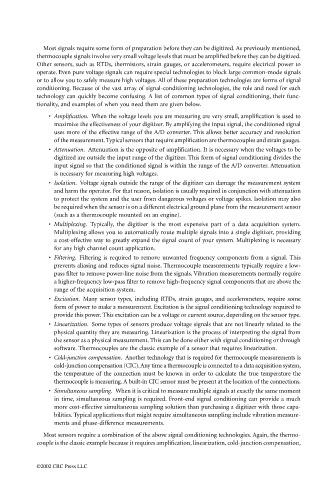Page 1227 - The Mechatronics Handbook
P. 1227
Most signals require some form of preparation before they can be digitized. As previously mentioned,
thermocouple signals involve very small voltage levels that must be amplified before they can be digitized.
Other sensors, such as RTDs, thermistors, strain gauges, or accelerometers, require electrical power to
operate. Even pure voltage signals can require special technologies to block large common-mode signals
or to allow you to safely measure high voltages. All of these preparation technologies are forms of signal
conditioning. Because of the vast array of signal-conditioning technologies, the role and need for each
technology can quickly become confusing. A list of common types of signal conditioning, their func-
tionality, and examples of when you need them are given below.
• Amplification. When the voltage levels you are measuring are very small, amplification is used to
maximize the effectiveness of your digitizer. By amplifying the input signal, the conditioned signal
uses more of the effective range of the A/D converter. This allows better accuracy and resolution
of the measurement. Typical sensors that require amplification are thermocouples and strain gauges.
• Attenuation. Attenuation is the opposite of amplification. It is necessary when the voltages to be
digitized are outside the input range of the digitizer. This form of signal conditioning divides the
input signal so that the conditioned signal is within the range of the A/D converter. Attenuation
is necessary for measuring high voltages.
• Isolation. Voltage signals outside the range of the digitizer can damage the measurement system
and harm the operator. For that reason, isolation is usually required in conjunction with attenuation
to protect the system and the user from dangerous voltages or voltage spikes. Isolation may also
be required when the sensor is on a different electrical ground plane from the measurement sensor
(such as a thermocouple mounted on an engine).
• Multiplexing. Typically, the digitizer is the most expensive part of a data acquisition system.
Multiplexing allows you to automatically route multiple signals into a single digitizer, providing
a cost-effective way to greatly expand the signal count of your system. Multiplexing is necessary
for any high channel count application.
• Filtering. Filtering is required to remove unwanted frequency components from a signal. This
prevents aliasing and reduces signal noise. Thermocouple measurements typically require a low-
pass filter to remove power-line noise from the signals. Vibration measurements normally require
a higher-frequency low-pass filter to remove high-frequency signal components that are above the
range of the acquisition system.
• Excitation. Many sensor types, including RTDs, strain gauges, and accelerometers, require some
form of power to make a measurement. Excitation is the signal conditioning technology required to
provide this power. This excitation can be a voltage or current source, depending on the sensor type.
• Linearization. Some types of sensors produce voltage signals that are not linearly related to the
physical quantity they are measuring. Linearization is the process of interpreting the signal from
the sensor as a physical measurement. This can be done either with signal conditioning or through
software. Thermocouples are the classic example of a sensor that requires linearization.
• Cold-junction compensation. Another technology that is required for thermocouple measurements is
cold-junction compensation (CJC). Any time a thermocouple is connected to a data acquisition system,
the temperature of the connection must be known in order to calculate the true temperature the
thermocouple is measuring. A built-in CJC sensor must be present at the location of the connections.
• Simultaneous sampling. When it is critical to measure multiple signals at exactly the same moment
in time, simultaneous sampling is required. Front-end signal conditioning can provide a much
more cost-effective simultaneous sampling solution than purchasing a digitizer with those capa-
bilities. Typical applications that might require simultaneous sampling include vibration measure-
ments and phase-difference measurements.
Most sensors require a combination of the above signal conditioning technologies. Again, the thermo-
couple is the classic example because it requires amplification, linearization, cold-junction compensation,
©2002 CRC Press LLC

